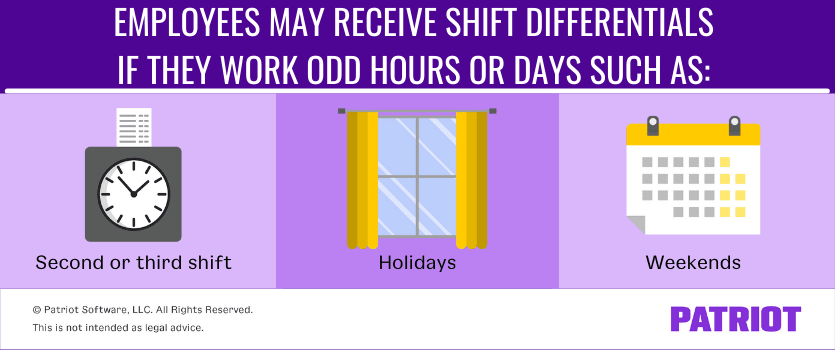Many employers find themselves extending their hours of operation to keep up with customer demands. Businesses operating day and night need employees who are willing to work evening or late shifts. However, it can be difficult to recruit employees for these undesirable hours.
Paying employees a shift differential is an effective way to overcome staffing challenges. Learn more about what is differential pay, who receives differential rates, and common shift differentials below.
What is shift differential?
Shift differential pay is extra compensation for employees who work a less desirable shift, such as evening or midnight shifts. The employer decides a shift differential rate and can negotiate this amount with an employee. The law does not require you to offer additional compensation, but it can help retain employees.
Instead of paying shift differentials, employers may choose to compensate employees with additional paid time off (PTO).
Employees working third shift are likely paid higher premiums than second shift. In addition to night shift differential, employers may offer weekend differential pay. Employers may choose to pay all employees weekend shift differentials versus only paying second or third shift employees the weekend shift differential.

Jobs with shift differentials
Shift differentials are common for customer support, security, healthcare, and manufacturing jobs. Shift type, level of responsibility, and experience can influence shift differential rates.
Managers in customer support roles have a wide range of responsibilities. They take on difficult customer concerns in addition to working later shifts. Due to the level of responsibility, they may receive a shift differential that is much higher than someone in a non-managerial role working the same shift.
Employees in the healthcare field (e.g., nurses and doctors) may get paid an extra amount or percentage of their regular pay to work a second or third shift. For example, an emergency care clinic could pay a doctor an additional $200 per night to work second shift instead of first shift.
A security position generally requires shifts with later hours. Working midnight shifts is not always appealing to potential employees.
Calculating shift differentials
Typically, employers set the shift differential as a percentage of wages. Employers decide what amounts to offer. Consider the responsibilities, experience, hours, and whether the employee is hourly vs. salary when determining a percentage or amount for shift differentials.
Calculating shift differentials manually is pretty straightforward. For hourly employees, a shift differential may be a percentage of the employee’s base rate or an extra flat amount per hour. Salaried employees are usually offered shift differentials as a percentage.
For example, an employee who works the “graveyard” shift may receive a pay differential of 10%. Let’s say an employee gets $20 per hour on the regular shift. With a 10% shift differential, the employee would be paid $22 per hour, with $2 per hour being the shift differential ($20 x 0.10 = $2).
Employees can also receive flat rate shift differentials. Let’s say a customer support employee works third shift. They make an additional $1.00 per hour. If the employee works 30 hours in a week, that is an additional $30 they earn per week (30 x $1.00).
An employee paid a salary may get a lump sum shift differential along with their regular wages. For example, a caretaker working third shift may get paid an additional $100 per shift. Add the extra $100 to regular wages as a shift differential. Check the U.S. Department of Labor website for more examples on calculating shift differentials for health care workers.
Employees working holiday shifts may receive time and a half. An employee who makes $10 per hour will receive $15 per hour for holiday pay if they are paid time and a half ($10 x 1.5 = $15).
Add the shift differential pay to the base rate before calculating overtime.
This article was updated from its original publication date of 6/22/2012.
This is not intended as legal advice; for more information, please click here.
